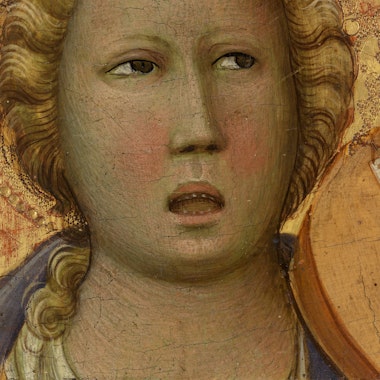Gherardo Starnina. Head of an Angel (detail), 1404–1406. BF1003. Public Domain.
Starnina’s ‘Head of an Angel’
By Amy Gillette, PhD, Barnes Foundation Art Team lead
On the south wall of Room 4, a small panel showing the head of a music-making angel crowns an ensemble composed of mostly medieval and Renaissance religious images. The angel has blond curls, one visible pink wing, and a halo with a floral design stamped onto the gold background. He is shown singing and playing a vielle, a medieval instrument similar to a violin. The image was painted by the Italian artist Gherardo Starnina, who spent some years working in Spain before returning to his home city of Florence.¹ The angel’s abstracted elegance, bright colors, and sumptuous effects are hallmarks of the International Gothic style, which Starnina had encountered in Spain and helped transmit to Italy.

Ensemble view: Room 4, south wall
Notice that the angel is looking toward some blue shapes at his left, a few wispy and one smoothly curved. These are traces of clouds and a mandorla, an almond-shaped halo that usually enveloped an image of the Virgin Mary depicted as the Queen of Heaven.²
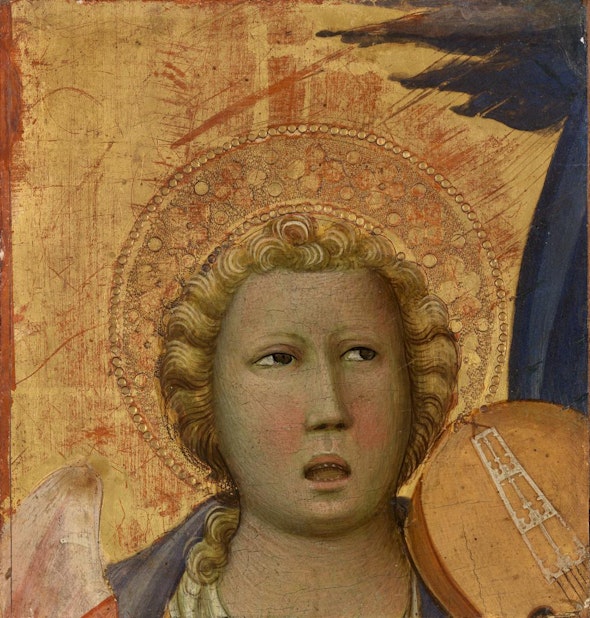
Gherardo Starnina. Head of an Angel, 1404–1406. BF1003. Public Domain.
The presence of the clouds and the mandorla, along with the panel’s small size, signal that the angel was not a stand-alone painting but part of a larger assemblage. Indeed, we now know that our angel belonged to a winged altarpiece depicting the Madonna and Child that was originally housed in an important monastery outside of Florence called the Certosa of Galluzzo. We can even reconstruct what the altarpiece would have looked like.
How did art historians piece together this mystery? A quasi-forensic search spanning decades was involved. When the panel first surfaced in the early 1900s in London, nothing was known about its origin. Luckily, the panel drew the attention of a close-knit community of art collectors, dealers, and scholars who were pioneers in the connoisseurship of early Italian painting. Their work involved, first and foremost, the enormous task of attributing paintings—many of them carved up and dispersed—to individual artists or workshops. The Starnina panel was first published in a 1925 survey of Lord Carmichael of Skirling’s collection with the attribution “school of Orcagna,”³ a detail that Berlin-based dealer Vitale Bloch passed along when he sold the panel to Albert Barnes in 1930.⁴ Dr. Barnes’s collaboration, and even friendship, with scholars in this circle highlights his position on the front lines of art history even as he rejected the tradition of encyclopedic display for his own idiosyncratic vision.⁵
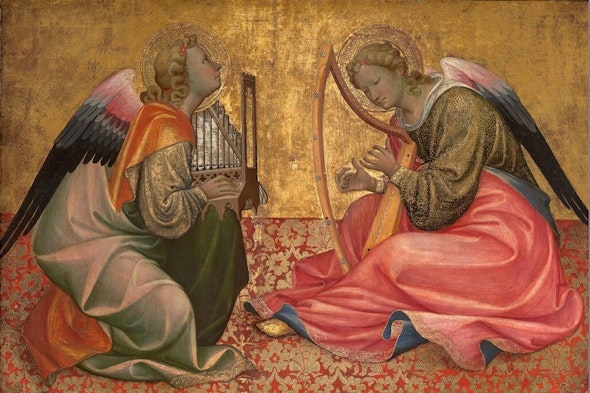
A fragment of the Starnina altarpiece, now in Museum Boijmans Van Beuningen in Rotterdam.
These early connoisseurs eventually built up a group of fragments associated with the Barnes angel, all the while seeking clues to their artist and original location. Their research included the physical inspection of other likely disjecta membra, or scattered fragments, as well as the review of assorted historical texts, such as artists’ contracts, wills, and eyewitness accounts. In 1974, Jeanne van Waadenoijen realized that the assembled fragments matched a description by the Florentine author Giorgio Vasari (d. 1574) of an altarpiece commissioned by Cardinal Angelo Acciaiuoli (d. 1408) for his newly built Chapel of the Virgin Mary in the Certosa of Galluzzo, just outside Florence.⁶ The Certosa, a center of Carthusian monasticism, was founded in 1341 by his father, Niccolò Acciaiuoli (d. 1365); it was a bastion of humanistic learning, one of the most powerful monasteries in Europe, and rich in artistic treasures until its spoliation in the early 19th century. Vasari wrote of the Certosa altarpiece:⁷
“[In this painting are] a Madonna with the Child in her arms, and with certain very beautiful angels at her feet, sounding instruments and singing; at the sides are St. Lawrence, St. Mary Magdalene, St. Zenobius [actually St. Hugh of Lincoln, identified by the white robe of the Carthusian order—Ed.], and St. Benedict; and in the predella are little stories of these Saints, wrought in little figures with infinite diligence.”
Giorgio Vasari
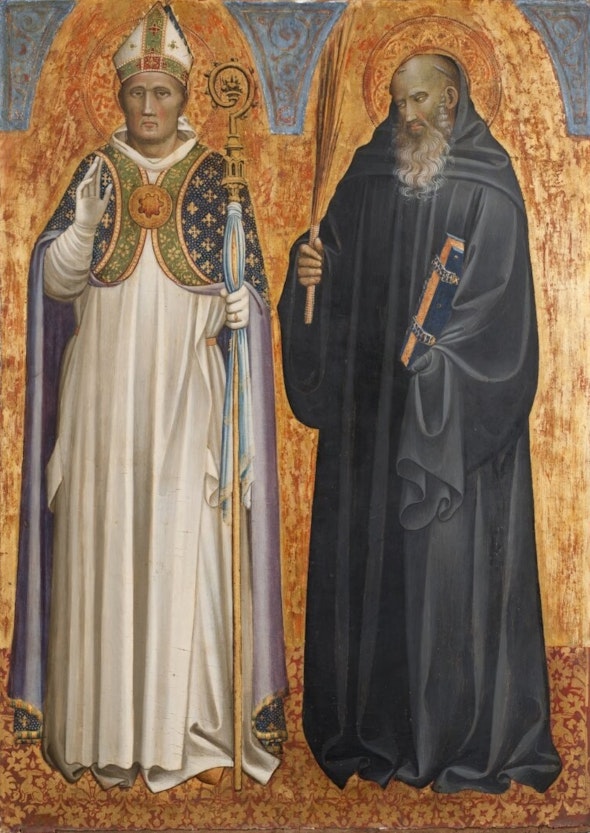
This panel depicting St. Hugh of Lincoln and St. Benedict once occupied the right wing of the altarpiece.
Vasari’s testimony helped to identify 13 additional fragments of the altarpiece, which are now dispersed across 11 museums and private collections. A reconstruction of the original arrangement is below.⁸ One piece shows the head of a lute-playing angel, identical in size to the fragment with the Barnes angel.⁹ The two angels flanked the Virgin and Child. Only the Virgin’s head has a known location, so another Virgin and Child by Starnina has been used as a surrogate, shaded in blue for differentiation.¹⁰ Below this group were angels playing the harp and the organ.¹¹ The altarpiece’s left wing shows SS. Mary Magdalene and Lawrence, with St. Lawrence recommending Cardinal Acciaiuoli to the Virgin Mary.¹² SS. Hugh of Lincoln and Benedict occupied the right wing.¹³ The narrative scenes of the bottom register, from left to right, were the Communion of St. Mary Magdalene,¹⁴ the Martyrdom of St. Lawrence,¹⁵ the Adoration of the Magi,¹⁶ the Miracle of St. Hugh,¹⁷ and the Miracle of St. Benedict.¹⁸ The pinnacles depicted Christ Blessing and the Annunciation.¹⁹
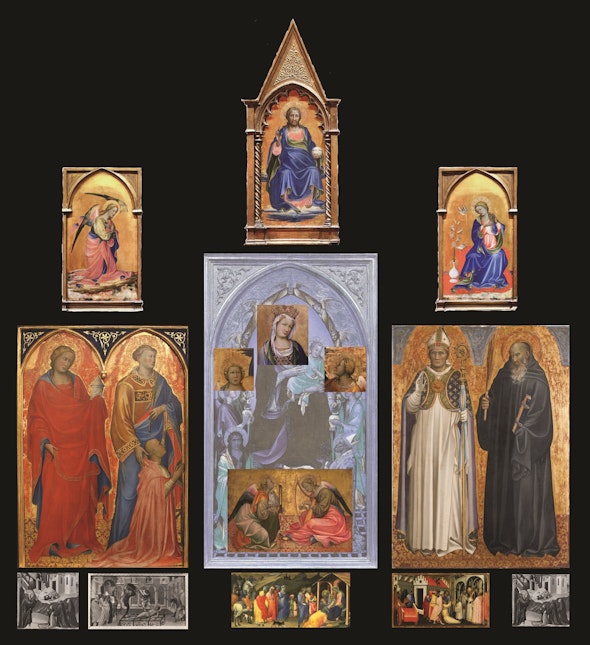
A reconstruction of the arrangement of the original altarpiece.
Reconstructing Starnina’s altarpiece helps us understand what the Barnes angel meant to its original viewers. As a whole, the monument placed four saints particularly honored at the Certosa in the exalted company of the Queen of Heaven. The inclusion of Cardinal Acciaiuoli shows his hope that, having followed these models of sanctity, he would one day be welcomed into heaven by the Virgin Mary; there, he too would sing praise for God in endless bliss. Installed within the chapel, the altarpiece also promoted the Carthusian monks’ communal goal of regaining Paradise. Medieval Christians believed that every church was, ritually and symbolically, a microcosm of heaven. They believed that angels celebrated an exemplary and eternal version of church rites in parallel to them and, at certain moments, even entered into the church’s physical space. One such instance was the culmination of the Mass, when the priest consecrated the Eucharistic bread and wine as the body and blood of Christ, at which point heaven and earth came together to sing the Sanctus (“Holy, Holy, Holy”) in one joyful chorus. Given this belief system, Starnina’s depiction of angel-musicians on a painting destined for an altar imagined their presence at the Mass and their status as fellow choristers alongside the monks, who found in angels’ song a source of comfort and joy, as articulated almost contemporaneously by the English friar Walter Hilton (d. 1396):²⁰
“Our Lord comforts a soul by angel’s song. This song cannot be described by any bodily likeness, for it is spiritual, and above all imagination and reason. (…) Just so, in the love of God, a soul by the presence of angels is ravished out of mind of all earthly and fleshly things and filled with a heavenly joy, to hear angel’s song and heavenly sound.”
Walter Hilton
This wonderful spiritual achievement of “hearing” angels’ song shouldn’t obscure the fact that Starnina’s main inspiration for his composition was actually a mechanized spectacle deployed for the edification and delight of laypeople in churches and piazzas. Vasari himself described these sundry “Paradise machines” installed in Florentine churches in Starnina’s time, and he was even charged with some of their maintenance. Generally, the machines featured a rotating domed superstructure (the “heaven”) suspended from the church’s rafters and containing an iron mandorla affixed to a pole that could be raised and lowered by a crane hidden in the roof. These heavens and mandorlas were packed with cotton-wool clouds, a huge amount of candles, and multiple young boys playing the role of musical angels. The effect was the very literal expression of what the Carthusian monks were supposed to derive from Starnina’s altarpiece, as Vasari remarked of a Paradise machine at San Felice: “The Heaven, the nosegay [of angels], the mandorla, with the numerous lights and sweet music, represented Paradise most realistically.”²¹ The pastoral benefits of such machines still required a little effort, given feedback from Don Vincenzo Borghini for Vasari’s work on a machine in Santo Spirito:²²
“More music in Heaven, but I don’t know whether wind instruments will be right. Rather, I’d reinforce the keyboards and strings. [Perhaps to drown out rumbling and clanking of winches?] Heaven should not lurch as it did yesterday evening. Lights, lights, lights! And I’m telling you, that however many you have they will still seem too few.”
Don Vincenzo Borghini
In sum, the collection and connoisseurship of Starnina’s angel-musician went hand in hand, over time leading to the discovery of its matched pieces. Once these fragments were identified as the Certosa altarpiece commissioned by Cardinal Acciaiuoli, Starnina’s angel could be understood as a promise of future bliss and praise for him and the monastic community, thanks largely to the mercy of the Virgin Mary, the example of the angels and saints, and the allure of popular spectacle.²²
Endnotes
¹ Starnina’s authorship is recognizable mainly by stylistic comparisons. One of the most notable is a smaller but otherwise nearly identical angel making music for the enthroned Virgin Mary and Christ Child in a devotional panel (c. 1410) at the Getty Museum.
² Two examples by Starnina are a panel of the Virgin and Child (Accademia, Florence) and an altarpiece of the Virgin’s Assumption to Heaven, lifted above the clouds by a crowd of angels (Fogg Museum, Harvard University).
³ Catalogue of the Collections formed by the Late Lord Carmichael of Skirling (London, 1926), 62; the Philadelphia Museum of Art’s copy of this auction catalogue indicates that Starnina’s angel was sold to the art historian Sir Martin Conway, London.
⁴ “Wir verkauften Ihnen ein Gemaelde: ‘Kopf eines Engels’ (Fragment), Italienischer Meister aus dem Kreise Orcagna.” N. S. Trivas. [Vitale Bloch’s partner] Letter to Albert C. Barnes, Berlin, May 22, 1930. President’s Files, Albert C. Barnes Correspondence, Barnes Foundation Archives.
⁵ See Osvald Siren, Tancred Borenius, Bernard Berenson, and Richard Offner.
⁶ The bibliography for the Certosa altarpiece is summarized by D. Parenti in Maria T. Filieri, Sumptuosa tabula picta: pittori a Lucca tra gotico e Rinaschimento (Livorno: Sillabe, 1998), 274-6. For assigning the altarpiece to Starnina and to the Certosa, see J. van Waadenoijen, “A proposal for Starnina,” in The Burlington Magazine 116 (1974): 84-91, esp. 89; Vasari mistook the altarpiece as a work of the young Fra Angelico (d. 1455) but the early date brought it in line with Starnina’s oeuvre. Cardinal Acciaiuoli’s will is included in the Conventi soppressi series, State Archives of Florence (ASF).
⁷ Giorgio Vasari, Life of Fra Angelico (1568/ed. 1878, II), 506.
⁸ Cf. the reconstruction by B. Berenson in Italian Pictures of the Renaissance: Florentine School, vol. 1 (New York, 1963), 140, pl. 476; still dated to c. 1422 and attributed to the patronage of Cardinal Corsini’s St. Lawrence Chapel in the Florence Duomo, after 1422.
⁹ Private collection, Genoa; Parenti, 274.
¹⁰ Dresden, Gemaeldegalerie; see R. Longhi, “Fatti di Masolino e di Masaccio,” Critica d’arte 5 (1940), 184; he associated this Madonna with the Barnes angel.
¹¹ Rotterdam, Boijmans Museum; T. Borenius, A History of Painting in Italy (London, 1913-4), 91.
¹² Berlin, Gemaeldegalerie; O. Siren, “Di alcuni pittori fiorentini,” L’Arte (1904), 349; attributed to the Maestro del Bambino Vispo.
¹³ Stockholm, Nationalmuseum; see G. Pudelko, “The Maestro del Bambino Vispo,” Art in America 26.2 (1938), 52-3.
¹⁴ Musée des Hospices, Lyon, France
¹⁵ Galleria Colonna, Rome; B. Colasani, “Quadri fiorentini inediti,” Bolletino dell’Arte (1933-4), 337-40.
¹⁶ Musée de la Chartreuse, Douai, France; Pudelko, 52-3.
¹⁷ Poldi-Pezzoli, Milan; Pudelko, 52-3.
¹⁸ Private collection, Florence; C. Volpe, “Per il completamento dell’altare di S. Lorenzo del Maestro del Bambino Vispo,” in Mitteilungen des Kunsthistorischen Institutes in Florenz 17 (1973), 175f.
¹⁹ Stadel Kunstinstitut, Frankfurt; R. Oertel, “Der Laurentius-Altar aus dem Florentiner Dom,” in Studien von toskanischen Kunst (Munich, 1964), 205-20.
²⁰ Walter Hilton, “Of Angel’s Song,” in The Cell of Self-Knowledge: Seven Early English Mystical Treatises Printed by Henry Pepwell in 1521, ed. E. Gardner (New York, 1910), 43-44.
²¹ Vasari’s account was probably relatively close to the 1439 design. See N. Newbigin, “Greasing the Wheels of Heaven: Recycling, Innovation, and the Question of ‘Brunelleschi’s’ Stage Machinery,” in I Tatti Studies on the Italian Renaissance 11 (2007).
²² Translated in Newbigin, 2007, 226.
